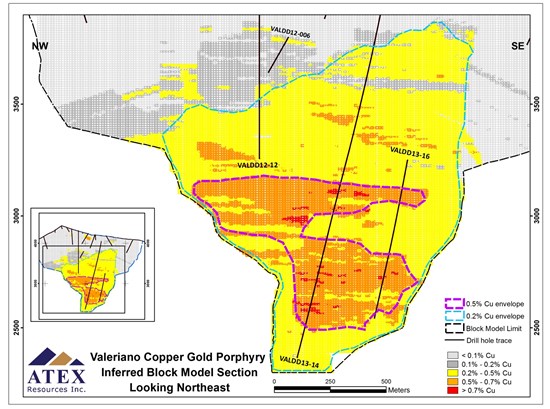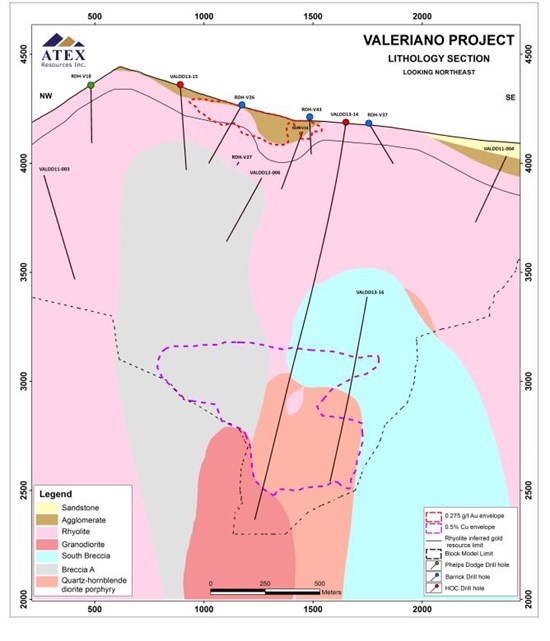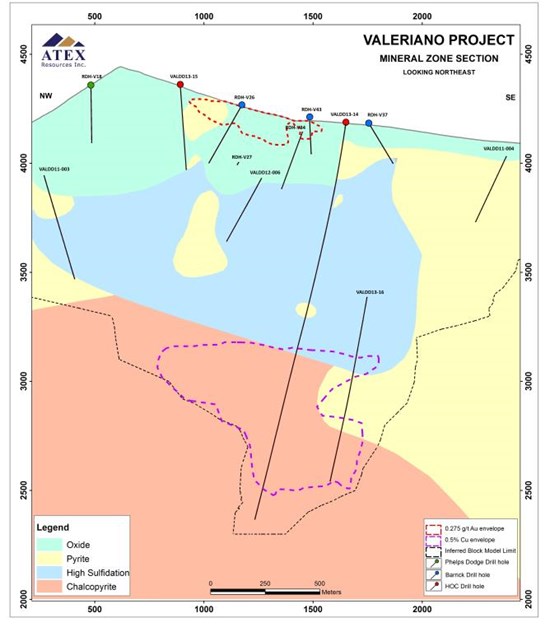Vancouver, British Columbia--(Newsfile Corp. - September 29, 2020) - ATEX Resources Inc. (TSXV: ATX) ("ATEX") is pleased to report initial resource estimates for two deposits on its Valeriano Copper Gold Project located in Chile's El Indio Belt. Both resource estimates were completed by SRK Consulting (Chile) SpA. ("SRK") on behalf of ATEX and have been prepared in accordance with the Canadian Institute of Mining and Metallurgy and Petroleum Definition Standards for Mineral Resources and Mineral Reserves (2014). A National Instrument 43-101 technical report will be appropriately filed within 45 days of this release.
Highlights
Gold Oxide Epithermal Deposit
- Maiden Gold Oxide Resource Estimate totals 34.4 Mt at 0.528 g/t Au and 2.4 g/t Ag (0.561 g/t Au eq.) in the Inferred Category at a 0.275 g/t Au cut-off grade.
- Contained metal totals 584,684 oz Au and 2,653,895 oz Ag for 621,539 Au eq. oz.
- Resource measures approximately 650 metres by 500 metres in plan extending to an average depth of 100 metres from surface (see Figures 1 & 2).
- Potential exists for additional near surface gold mineralization.
Copper Gold Porphyry Deposit
- Maiden Copper Gold Porphyry Resource Estimate of 297.3 Mt at 0.59% Cu, 0.193 g/t Au and 0.90 g/t Ag (0.77% Cu eq.) in the Inferred Category at a cut-off grade of 0.50% Cu.
- Contained metal totals 1.77 Mt Cu, 1.84 M oz Au and 8.62 M oz Ag for 2.30 Mt Cu eq.
- Porphyry mineralization is open in all directions horizontally and to depth (see Figure 3).
- Highest Cu & Au grades are associated with a granodiorite porphyry and breccia bodies (see Figure 4); drill testing extensions of these bodies is a priority.
Commenting on the maiden resource estimates, Raymond Jannas, ATEX's CEO stated: "We are very pleased with the two initial resource estimates prepared by SRK. As we have previously disclosed, our near-term focus is on outlining an economically viable, heap leachable gold resource close to surface and our maiden gold oxide resource is a strong step in this direction. This season, we are planning on additional drilling to confirm and expand on the current resource and preliminary metallurgical testing of the oxide mineralization has commenced. The drilling and metallurgical test work are the first steps towards evaluating the possibility of initiating a preliminary economic assessment.
While our current focus is moving the gold oxide resource forward, the initial porphyry resource estimate suggests that Valeriano property has the potential to host a significant underground copper gold porphyry deposit. Currently, the porphyry copper gold mineralization is open horizontally in all directions and to depth."
Gold Oxide Resource Estimate
An inferred resource of 34.4 million tonnes grading 0.528 grams per tonne ("g/t") gold ("Au") and 2.40 g/t silver ("Ag") for a combined gold equivalent ("Au eq.") grade of 0.561 g/t has been estimated for a total of 584,684 ounces ("oz") of Au and 2,653,895 Ag oz or 621,539 Au eq. oz (see Table 1 & Figures 1 & 2). The gold oxide resource is associated with high-sulphidation style, epithermal gold and silver mineralization developed within volcanic and volcaniclastic host rocks overlying the Valeriano copper gold porphyry system.
Table 1. - Valeriano Gold Oxide Resource Estimate - Inferred
| Cut-off Au (g/t) | Tonnes | Grade | Ounces | ||||
| Au (g/t) | Ag (g/t) | Au Eq. (g/t) | Au | Ag | Au Eq. | ||
| 0.200 | 62,819,175 | 0.395 | 2.16 | 0.425 | 797,662 | 4,361,385 | 858,244 |
| 0.225 | 51,842,530 | 0.434 | 2.22 | 0.464 | 722,647 | 3,691,909 | 773,917 |
| 0.250 | 41,119,097 | 0.485 | 2.32 | 0.517 | 641,089 | 3,065,582 | 683,664 |
| 0.275 | 34,435,360 | 0.528 | 2.40 | 0.561 | 584,684 | 2,653,895 | 621,539 |
| 0.300 | 28,900,615 | 0.574 | 2.44 | 0.608 | 533,581 | 2,269,764 | 565,106 |
| 0.350 | 20,891,789 | 0.670 | 2.56 | 0.706 | 450,033 | 1,719,813 | 473,922 |
| 0.400 | 15,750,241 | 0.767 | 2.61 | 0.804 | 388,574 | 1,321,227 | 406,924 |
- Mineral resources are not confined by economic or mining parameters.
- Cut-off grades are for reporting purposes only and no economic conditions are implied.
- Au equivalent grades are calculated based upon a Au price of $1,800 per oz and a Ag price of $25.00 per oz (all prices in US$). Minor discrepancies may exist due to rounding. Metal recoveries were not considered.
- Formula for Au Eq.% calculation:

If can't see the equation, please visit:
https://orders.newsfilecorp.com/files/6303/64768_25f0ab4c84063a43_006full.jpg - Tonnage and grade estimates are in metric units. Contained gold ounces are reported as troy ounces.
- Estimated copper grades, at the 0.275 g/t cut-off grade, are 0.06%.
A preliminary metallurgical testing program, comprising up to 6 bottle roll tests undertaken on available coarse rejects of sampled drill core from previous drill programs, has commenced. The metallurgical test work will determine preliminary gold recoveries, leaching time (leach kinetics) and approximate amount of consumables required. It is expected that the initial results from the test work will be available early in 2021.
Copper Gold Porphyry Resource Estimate
Underlying and separate from the gold oxide resource and below the high-sulphidation style alteration, lies the Valeriano copper gold porphyry mineralization which has been estimated to host an initial inferred resource of 297.30 million tonnes grading 0.59% copper ("Cu"), 0.193 g/t Au and 0.90 g/t Ag (copper equivalent ("Cu eq.") grade of 0.77%) for an estimated 1.77 million tonnes of contained Cu, 1.844 million oz of contained Au and 8.62 million oz of contained Ag (see Table 2 & Figure 3) or 2.3 million tonnes Cu eq. The porphyry resource has been tested by four drill holes and is open horizontally in all directions and to depth.
Table 2. - Valeriano Copper-Gold Porphyry Resource Estimate - Inferred
| Cut-off Cu (%) | Tonnes (millions) | Grade | Contained Metal | ||||||
| Cu (%) | Au (g/t) | Ag (g/t) | Cu Eq. (%) | Cu (tonnes) | Au (oz) | Ag (oz) | Cu Eq. (tonnes) | ||
| 0.2 | 684.58 | 0.49 | 0.163 | 0.91 | 0.64 | 3,321,772 | 3,590,244 | 20,039,444 | 4,374,922 |
| 0.3 | 645.33 | 0.50 | 0.167 | 0.91 | 0.66 | 3,225,909 | 3,473,140 | 18,882,439 | 4,242,805 |
| 0.4 | 515.43 | 0.53 | 0.180 | 0.97 | 0.70 | 2,746,126 | 2,986,710 | 16,030,960 | 3,619,818 |
| 0.5 | 297.30 | 0.59 | 0.193 | 0.90 | 0.77 | 1,766,743 | 1,844,884 | 8,621,904 | 2,301,579 |
| 0.6 | 142.93 | 0.65 | 0.198 | 0.81 | 0.83 | 926,661 | 908,024 | 3,730,162 | 1,187,958 |
| 0.7 | 15.74 | 0.73 | 0.235 | 0.91 | 0.95 | 115,180 | 118,723 | 458,731 | 149,235 |
- Mineral resources are not confined by economic or mining parameters.
- Cut-off grades are for reporting purposes only and no economic conditions are implied.
- Cu equivalent grades are calculated based upon a Cu price of $3.00 per pound, Au price of $1,800 per oz and Ag price of $25.00 per oz (all prices in US$). Minor discrepancies may exist due to rounding. Metal recoveries were not considered.
- Formula for Cu Eq.% calculation:

If can't see the equation, please visit:
https://orders.newsfilecorp.com/files/6303/64768_25f0ab4c84063a43_008full.jpg - Tonnage and grade estimates are in metric units. Contained gold ounces are reported as troy ounces.
Resource Estimation Methodology
The Gold Oxide Resource Estimate (see Figures 1 & 2) is based upon 4,455 metres in 55 drill holes (1,148 metres in 19 diamond drill holes and 3,307 metres in 36 reverse circulation drill holes) from the 1990's Barrick Gold Corp. ("Barrick") and Phelps Dodge Corporation ("Phelps Dodge") exploration programs and from Hochschild Mining plc's ("Hochschild") 2011 to 2013 drilling programs. A total of 2,209 composites were used in the estimation, virtually all 2 metres length. The resource estimation units are based on ATEX's three-dimensional models for lithology and mineralization (see Figures 4 & 5, respectively) that were built using geological units from Hochschild's core logging and taking into account structure controls and correlogram reach.
The Gold Oxide Resource Estimate lies within the oxide 3-D shell and is confined to three volcanic and volcaniclastic units (sandstone, agglomerate and rhyolite). The majority of the Oxide Resource extends to depths of approximately 100 metres below surface, locally extending deeper. Within the rhyolite sequence, the Oxide Resource is restricted to upper 85 metres of the rhyolite unit as statistical analyses shows that the gold grade drops significantly below that horizon.
After geostatistical analysis of the gold grades within the 3-D estimation units, and prior to the resource estimation, mineralized versus non-mineralized material was defined by indicator kriging for each unit. Variography was analyzed by means of correlogram maps, down the hole correlograms and directional correlograms. Final results indicated an overall horizontal isotropy and vertical anisotropy. The resource was estimated via Ordinary Kriging in 4 passes. Samples assaying greater than 4.00 g/t Au in agglomerate, 1.65 g/t Au in upper rhyolite and 0.29 g/t Au in sandstone were capped. The resulting 10 x 10 x 10-metre block model was validated by means of global and conditional bias assessments as well as by drift analyses.
The Copper Gold Porphyry Resource Estimate (see Figure 3) is based upon 2,701 metres of diamond drilling in four drill holes completed by Hochschild. A total of 1,353 composites were used in the estimation, almost all with a length of 2 metres. The Porphyry Resource is limited to the zone of dominant chalcopyrite copper mineralization. The three-dimensional chalcopyrite model was built using Hochschild core logging information taking into account structure controls. The chalcopyrite 3D shell was separated in two units: 1) higher grade being hosted within the granodiorite porphyry and the south breccia ("Cpy_gd_bx"); and 2) moderate grade within all other intrusives, breccias and rhyolite host rock ("Cpy_other"). After geostatistical analysis of copper grades within the 3-D estimation units, and prior to the resource estimation/calculation, mineralized versus non-mineralized material was defined by indicator kriging for each unit. Variography was analyzed by means of correlogram maps, down the hole correlograms and directional correlograms. Final results indicated an overall horizontal isotropy and vertical anisotropy. The resource was estimated via Ordinary Kriging in 4 passes. Samples assaying greater than 1.2% Cu in Cpy_gd_bx and 1.0% Cu in Cpy_other were capped. Gold grades were capped in the chalcopyrite shell by host-rock: 0.80 g/t Au (granodiorite), 0.53 g/t Au (rhyolite, diorite porphyry & breccia) and 0.47 g/t Au (south breccia & PQDH). The resulting 10 x 10 x 10-metre block model was validated by means of global and conditional bias assessments as well as by drift analyses.
No specific gravity measurements have been completed on mineralized material from either the oxide gold resource or the copper gold porphyry resource. An estimated specific gravity of 2.5 has been used for both resource estimates. Samples for specific gravity analyses are currently be collected from drill core from the 2012 - 2014 drilling program.
Given the current drill density for the Porphyry Resource, partial lack of data for complete QA/QC analyses in the Oxide Resource and absence of specific gravity data, both resource estimates have been classified as inferred.
Quality Assurance / Quality Control Program
The diamond drilling core from Hochschild's 2011 to 2013 drilling campaign were collected and sampled under the direct supervision of Hochschild's staff. Diamond drill core was placed in core boxes at the drill site, appropriately tagged, secured and transported to the Hochschild's exploration camp. Drill core was logged, marked, on average, at 2 metre intervals for sampling and split longitudinally with a diamond drill saw. One half of the core was bagged and sample tags attached and the second half of the core was returned to the core boxes. All samples were appropriately labelled and transported by truck by Hochschild personnel to the ALS Chemex laboratory located in Coquimbo, Chile. ALS Chemex-Coquimbo carried out preparation, chemical analyses and QA/QC. The preparation protocol (PREP-31B) consisted of crushing 70% to less than 2 mm (-10#), rotary split of 1 kg and pulverization to better than 85% passing 75 microns (-150#). Gold was analyzed via 50-gram fire assay and AA. Thirty-five additional elements, which included Cu, Ag, molybdenum and arsenic were assayed using aqua regia digestion and ICP-AES analysis (protocol ME-ICP41).
Hochschild's QA/QC protocol for drill hole samples included field, coarse reject and pulp duplicates of samples, blanks, and Au and Cu standards. At least 20% of the samples were sent for assay comprised quality assurance duplicates, blanks and standards.
ATEX reviewed QA/QC data obtained during Hochschild's 2011-2013 drilling campaigns. A total of 7,397 drillhole samples were collected in holes VALDD-01 through VALDD-16. Details are as follow:
- Field, coarse reject and pulp duplicates totalled 890 Au assays of which 342 were assayed for Cu.
- A total of 345 standards were inserted; 323 Au standards and 22 Cu standards.
- A total of 628 coarse (-10#) and fine (-150#) blanks were assayed.
Overall conclusions drawn from the QA-QC analyses are as follows:
- Analyses of duplicates show good precision indicating that the protocols used for sample preparation and assaying were adequate.
- Analyses of standards used during exploration show good accuracy, however, one Au standard showed a consistent negative basis (-15.77%).
- Analyses of blanks showed no serious contamination problems between samples.
The overall conclusion is that the available QA-QC data generated by Hochschild for the Valeriano drill program meets acceptability criteria for the stage of the project and the exploration data can be used for modeling and estimation of inferred resources.
There is no QA/QC data available from the Phelps Dodge drilling program. From drill logs, it is apparent that diamond core was sampled based upon geological controls in areas of potential mineralization and was sampled and assayed at 1-metre intervals in areas of no apparent mineralization. Drill core recovery appears to have been good. The sampling protocol resulted in variable sample lengths in areas of interest typically from 10 to 50 centimeters. In the case of reserve circulation drill holes, sampling was completed at 1-metre intervals and the entire drill hole was sampled and assayed. There is no information available regarding the sample preparation or assaying methods used by Phelps Dodge.
There is no QA/QC data available and little sample or assaying methodology information available from the Barrick reverse circulation drilling program other than sampling was undertaken at 1-metre intervals and sampling commenced at the beginning of the drill holes.
Considering the seniority of the companies and the professionals involved at the time, there is no apparent reason to question the validity of the Phelps Dodge or Barrick assaying information. The assay results are internally consistent within the oxide resource area, geologically reasonable for the type of deposit and intensity of mineralization, and are comparable to the assay results returned by Hochschild drilling in the same area. It is therefore considered reasonable that these results be included in the estimation of an inferred resource on an early stage exploration property.
Details of historical exploration, including drilling, sampling and assaying, together with ATEX's QA-QC analysis and commentary are available in the "NI 43-101 TECHNICAL REPORT ON THE VALERIANO PROJECT, ATACAMA REGION, CHILE" dated November 25, 2020 and filed at www.sedar.com.
NI 43-101 Disclosure
SRK Consulting (Chile) SpA. undertook to prepare and is responsible for the resource estimate. Joled Nur, Civil Mining Engineer, SRK Consulting (Chile) SpA and a member of the Public Register of Competent Persons in Mining Resources and Reserves of Chile, No. 181, is the independent qualified person ("QP"), as defined by National Instrument 43-101 Standards for Disclosure for Mineral Projects, who prepared the resource estimates. Mr. Nur has reviewed and approved the disclosure related to the resource estimates within this press release.
David Hopper, the independent QP for the Valeriano Project, is a Chartered Geologist of the Geological Society of London, Fellow No. 1030584. Mr. Hopper has reviewed and approved the technical disclosure within this press release.
The Valeriano resource estimates have been prepared under Canadian Institute of Mining, Metallurgy and Petroleum Definition Standards (2014).
About ATEX Resources Inc.
ATEX is a mineral exploration company focused on the acquisition, development and monetization of projects throughout the Americas. ATEX's flagship property is the Valeriano Copper Gold Project located in the northern portion of Chile's prolific El Indio Belt.
On behalf of ATEX Resources Inc.
Dr. Raymond Jannas
For more information, email info@atexresources.com or call 1-647-287-3778.
Forward Looking Information - This news release contains forward-looking statements, including predictions, projections and forecasts. Forward-looking statements include, but are not limited to: plans for the evaluation of the Valeriano property; the success of evaluation plans; the success of exploration activities; mine development prospects; and, potential for future metals production. Often, but not always, forward-looking statements can be identified by the use of words such as "plans", "planning", "expects" or "does not expect", "continues", "scheduled", "estimates", "forecasts", "intends", "potential", "anticipates", "does not anticipate", or describes a "goal", or variation of such words and phrases or state that certain actions, events or results "may", "could", "would", "might" or "will" be taken, occur or be achieved.
Forward-looking statements involve known and unknown risks, future events, conditions, uncertainties and other factors which may cause the actual results, performance or achievements to be materially different from any future results, prediction, projection, forecast, performance or achievements expressed or implied by the forward-looking statements. Such factors include, among others, changes in economic parameters and assumptions, the interpretation and actual results of current exploration activities; changes in project parameters as plans continue to be refined; the conversion of inferred resources to the measured and indicated category; the results of regulatory and permitting processes; future metals price; possible variations in grade or recovery rates; failure of equipment or processes to operate as anticipated; labour disputes and other risks of the mining industry; the results of economic and technical studies, delays in obtaining governmental approvals or financing or in the completion of exploration, as well as those factors disclosed in ATEX's publicly filed documents.
Although ATEX has attempted to identify important factors that could cause actual actions, events or results to differ materially from those described in forward-looking statements, there may be other factors that cause actions, events or results not to be as anticipated, estimated or intended. There can be no assurance that forward-looking statements will prove to be accurate, as actual results and future events could differ materially from those anticipated in such statements. Accordingly, readers should not place undue reliance on forward-looking statements.
Neither the TSX Venture Exchange nor its Regulation Services Provider (as that term is defined in the policies of the TSX Venture Exchange) accepts responsibility for the adequacy or accuracy of this press release.

Figure 1. Plan View showing the outlines of the gold mineralization projected from the 4200-metre elevation inferred resource block model (Figure 2). The NW-SE A-A' Section (Figure 2 - Gold Oxide Inferred Block Model Section) is indicated by a solid black and the NW-SE B-B' Section (Figures 3, 4 & 5 - copper gold porphyry related sections) is indicated by a dashed black line. RDH refers to reverse circulation drill holes; DDH & VALDD refer to diamond drill holes. Drill holes completed by: Phelps Dodge - DDH-V1 to 9 & RDH-V10 to 25; Barrick - RDH-V26 to 45; Hochschild - VALDD-01 to 16.
To view an enhanced version of Figure 1, please visit:
https://orders.newsfilecorp.com/files/6303/64768_25f0ab4c84063a43_001full.jpg
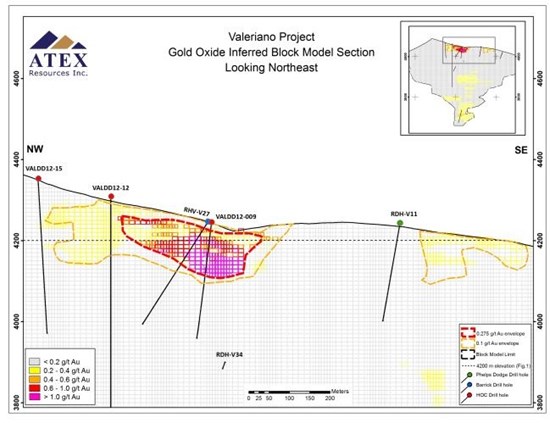
Figure 2. NW-SE Block Model Section (A - A', figure 1) looking NE through the gold oxide inferred resource block model. The 4200m elevation (Figure 1) is indicated by a dashed black line. Drill hole traces have a 50 m of influence on each side. RDH refers to Reverse circulation drill holes; DDH & VALDD refer to diamond drill holes. Drill holes completed by: Phelps Dodge - DDH-V1 to 9 & RDH-V10 to 25; Barrick - RDH-V26 to 45; Hochschild - VALDD-01 to 16.
To view an enhanced version of Figure 2, please visit:
https://orders.newsfilecorp.com/files/6303/64768_25f0ab4c84063a43_002full.jpg
Figure 3. NW-SE Block Model Section (B-B', figure 1) looking NE at the copper gold porphyry inferred resource block model. Drill hole traces have a 50 m of influence on each side. RDH refers to reverse circulation drill holes; DDH & VALDD refer to diamond drill holes. Drill holes completed by: Phelps Dodge - DDH-V1 to 9 & RDH-V10 to 25; Barrick - RDH-V26 to 45; Hochschild - VALDD-01 to 16.
To view an enhanced version of Figure 3, please visit:
https://orders.newsfilecorp.com/files/6303/64768_25f0ab4c84063a43_003full.jpg
Figure 4. NW-SE Lithology Section (B-B', figure 1) looking NE through the lithology 3-D model defined by ATEX and used in the current inferred resource modelling. Drill hole traces have a 50 m of influence on each side. RDH refers to Reverse circulation drill holes; DDH & VALDD refer to diamond drill holes. Drill holes completed by: Phelps Dodge - DDH-V1 to 9 & RDH-V10 to 25; Barrick - RDH-V26 to 45; Hochschild - VALDD-01 to 16.
To view an enhanced version of Figure 4, please visit:
https://orders.newsfilecorp.com/files/6303/64768_25f0ab4c84063a43_004full.jpg
Figure 5. NW-SE Mineralization Section (B-B', figure 1) looking NE through the mineral zones 3-D model defined by ATEX and used in the inferred resource modelling. Drill hole traces have a 50 m of influence on each side. RDH refers to Reverse circulation drill holes; DDH & VALDD refer to diamond drill holes. Drill holes completed by: Phelps Dodge - DDH-V1 to 9 & RDH-V10 to 25; Barrick - RDH-V26 to 45; Hochschild - VALDD-01 to 16.
To view an enhanced version of Figure 5, please visit:
https://orders.newsfilecorp.com/files/6303/64768_25f0ab4c84063a43_005full.jpg
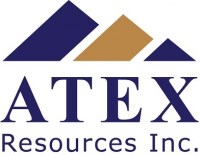
To view the source version of this press release, please visit https://www.newsfilecorp.com/release/64768
Source: ATEX Resources Inc.

